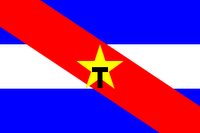 The following is Douglas Oliver's own introduction to selected "Diagram Poems" in A Various Art. This book is basically, as far as I can see, an anthology of "Cambridge poets": Prynne et. al. Many thanks to John Latta for the reference.
The following is Douglas Oliver's own introduction to selected "Diagram Poems" in A Various Art. This book is basically, as far as I can see, an anthology of "Cambridge poets": Prynne et. al. Many thanks to John Latta for the reference.We used to get the Tupamaros stories on the night shift at Agence France-Presse. Reports of urgent, sometmes bloody events would be wired through in Spanish, translated on the French floor, and reach our desk to be retranslated into English. At every step the events moved away from reality. Orchestrated by the Tupamaros for maximum heroic effect, they were transformed into Spanish news rhetoric, into French, into very different English news rhetoric, and then might appear in the columns of Asahi Shimbum, in whatever rhetoric the Japanese use.I like very much the idea of an "impure art" whose job is "to recreate emotional urgency out of fantasy."
Uruguay itself, the poverty brought about by the crash of world wool and meat markets and by the exploitation of the indigenous population by Western financial interests . . . this lay somewhere behind the bravado of exploit you were reporting. Whether the guerrillas were right or wrong--and you were against extremist violence, along with the rhetoric that falsified events at their origin--you might be dreaming quite obliquely, as you tapped the stories out, of how an authentic politics could combine the mildness of a dead baby of yours, dear in memory, with the stern wisdom of elder ministers truly backed by their people.
In Pando the Tupamaros seized the police and fire stations, the telephone exchange and three banks, before trying to escape as the police closed in on them. These movements could be plotted on to paper, already with some inaccuracy. As the diagrams were plotted, they moved farther away from reality into pictures which both reflected the actual events but were also permitted an infection from personal British fantasy, such as the dead son and your worries about political judgment. Poems emerged, more distorting even than journalism. The final job of this deliberately impure art was to recreate emotional urgency out of fantasy. (214)
For more on the "Diagram Poems," see here. More to come.
No comments:
Post a Comment